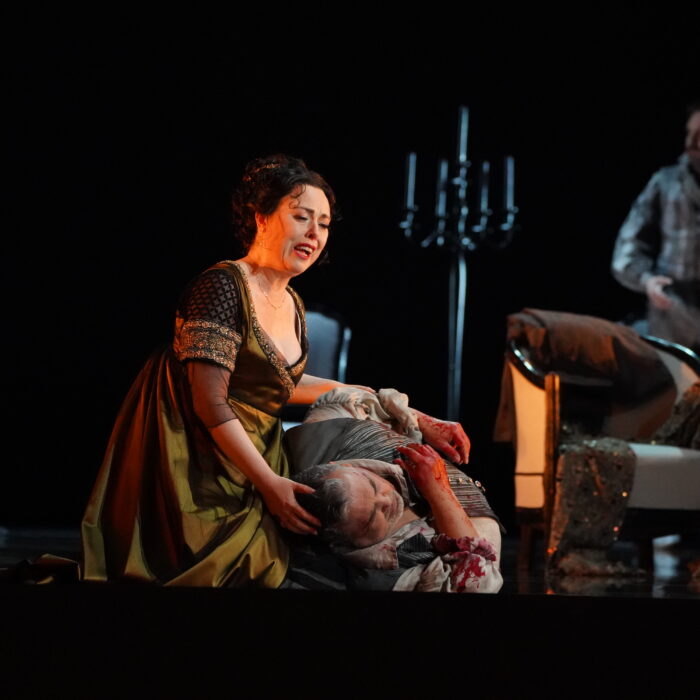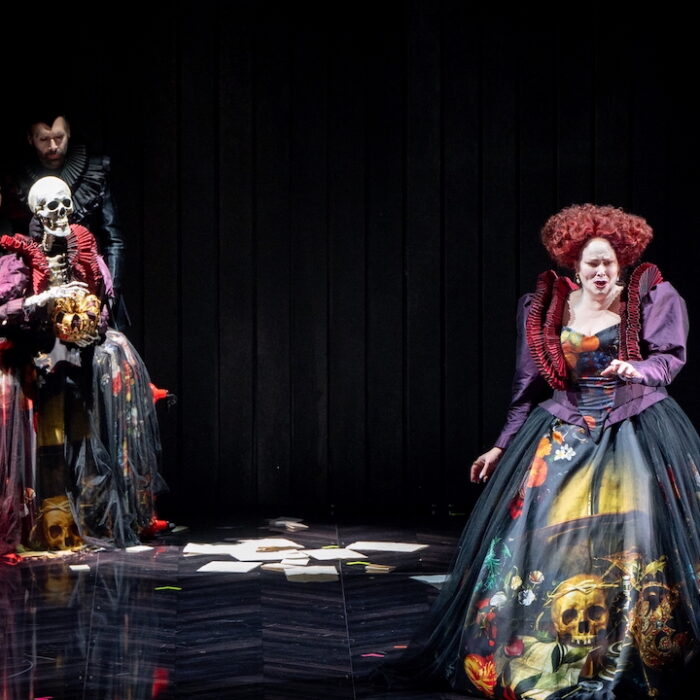
Opéra Royal de Wallonie-Liège 2021-22 Review: Otello Ossia il Moro di Venezia
Salome Jicia Shines in Performance Troubled by Ailing Lead
By Mauricio VillaThe Opera Royal de Liege Wallonie staged a brand-new production of Rossini’s “Otello.” The once-popular opera used to be performed worldwide in Rossini’s time but disappeared from the repertoire completely when Verdi’s “Otello” premiered in 1887.
But that wasn’t all. Rossini’s version also fell out of the rotation for the same reasons many bel canto works disappeared: the realism and new concept of drama which appeared at the end of the 19th century made Romantic operas out to be melodramas with weak plots. Moreover, the development of the tenor voice technique using chest resonance rendered the high tessitura extremely difficult to sing.
However, since true lirico-leggero tenors and “baritenors” have reappeared during the Rossini renaissance at the end of the 20th century, forgotten operas, like this title, are re-entering the repertoire— mostly thanks to the labor of maestro Alberto Zedda and the creation of the Pesaro Rossini Opera Festival which revived most of Rossini’s catalog.
Tale of Four* Tenors
Before the beginning of the show, the company announced that Russian tenor Sergey Romanovsky, who was cast in the title role, felt unwell but would still sing. But when he sang the first line, it was obvious that he was hoarse in the middle register, leaving him with little he could sing because his upper and lower register were completely gone.
Otello’s role begins with a big cavatina “ Vincemmo…Ah si, per voi già sento” which is profusely ornamented and has a tessitura that covers two octaves from low A to high A. Romanovsky did his best to finish the piece, marking passages, singing one octave lower, skipping coloratura, and keeping the voice in the middle in order to avoid moving the voice up or under the stave. It was a very difficult moment for Romanovsky, as we could clearly see that the tenor was making a big effort but was deeply uncomfortable. As soon as he finished the aria, the stage managers placed a music stand at the side of the stage and the tenor Anton Rositskiy sang the rest of the opera while Romanovsky played the scene mute.
Few singers dare to sing such extremely demanding roles and finding a good covering artist who knows and can sing the music when a singer falls sick is no easy feat. Rosistskiy proved up to the task and sang a solid Otello. His voice was lyrical, which wasn’t ideal for a baritenor role, but his center was strong and he was strong in the high register, as proved when tackling several high C’s and what seemed like an impossible, sustained high D in his duet with Rodrigo, “Ah vieni, nel tuo sangue” in Act two. His voice was always present in ensembles. It was a shame he did not sing the opening cavatina, which is the more demanding and spectacular piece of the role. But he delivered a clean coloratura during his duet with Jago and final duet with Desdemona.
Tenor Maxim Mironov portrayed the role of Rodrigo. He is no stranger to the part and has interpreted it in several productions (You can listen to him on a live CD recording released by Dynamic). His voice is probably the closest to that of the role’s originator, Giovanni David, the tenore contraltino for whom Rossini wrote the part. His voice is modest in volume, has a white quality, and can sustain high tessitura and deliver notes with ease. His famous aria “Che acolto!” showed all the tenor’s qualities. His voice runs easily in a high tessitura (which is written around a high B flat). His coloratura was clean, and his top notes secure.
Even so, his voice sounded small and less bright—especially in the higher register. And although he might be closer to the original sound Rossini wanted, we are accustomed today to lirico-leggero tenors whose voices have more squillo, projection, and strength. For instance, when Rosistskiy, soprano Salome Jicia, and Mironov finished their Act two trio by interpolating a high C, Mironov’s voice was completely hidden under his colleagues’ high C’s. This being said, however, I found his singing and interpretation faultless.
Italian tenor Giulio Pelligra sang the ungrateful role of Yago, a comprimario delegated to duets and supporting lines, with little dramatic weight (Especially if we look at Shakespeare/ Boito/Verdi Yago) but with un uncomfortable tessitura written constantly in the passaggio zone and rising often to high B flats. He was brilliant in his Act two duet with Otello,“ Non, m’inganno,” and his well-projected bright voice melted perfectly with Rosistskiy.
Lyric Showstopper
The young Georgian lyric soprano Salome Jicia interpreted the role of Desdemona. This pure lyric soprano has mostly dedicated her repertoire to bel canto and Mozart. Jicia has a powerful, bright voice that grows in volume as she rises to the higher register. Desdemona’s part has four chromatic ascensions to high Cs, two in the final concertante of Act one and two more in the trio with Otello and Rodrigo in Act three. Jicia delivered four impossibly big high C’s, which were perfectly audible over the voices of the rest of her colleagues and chorus.
But ultimately, it was the lyrical nature of her voice that made her succeed in such a difficult role, as her middle register is strong. Rossini’s soprano roles for Naples were composed for Isabella Colbran, who according to the chronicles of that period had a mezzo-soprano timbre but an astonishing ability to coloratura; that is why it is so difficult to cast those roles. Leggera sopranos have trouble with the central tessitura of the role, despite all the high notes and variations that they add. Mezzo-sopranos have tried to sing Colbran roles, but they mostly have problems with the top sections. Jicia offered a thrilling interpretation of her big scene and aria “Che smania! Ahimè!” at the end of Act two. She portrayed a strong woman, who confronts her father, faces a cynical society, and bravely defends herself when facing death at the hands of Otello.
The Italian conductor Maurizio Benini is a bel canto specialist, having dozens of Rossini, Bellini, and Donizetti titles in his repertoire. Unfortunately, he chose extremely pesante and slow tempi for most of the opera, making the action slow, which did not reinforce the dramatic power of Rossini’s music.
It’s clear that “Otello” is not a Rossini opera buffa, The famous “Rossini’s crescendo” is not clearly present, and Benini’s tempi killed the action during several moments, beginning with the overture and finishing with a languid Desdemona “willow song” and a weak final storm, which was greatly reinforced by audio effects of thunder and wind. Despite the lacking musical interpretation, the Orchestra of the Royal Opera de Wallonie sounded clear and with a bright blending sound.
Bringing Out Rossini’s Drama
Having a 40-year career directing opera, prolific Spanish director Emilio Sagi’s style could be described as traditional with a modern approach. He could be viewed as the bridge between the obsolete, old operatic tradition and the extremes of modernism, dramaturgy, and conceptual works mostly done today. Sagi is above all an aesthete, his work is always beautiful to see and this new production of Rossini’s “Otello” did not disappoint at all.
Sagi set the action at the beginning of the 20th century, right after World War I, within the main hall of a Victorian mansion. With the sets and costumes in white and grey tonalities, plus a snowy landscape as the background of the huge windows of the mansion, the sense of extreme coldness reflects the bourgeoise society’s double morals, corruption, classicism, and racism.
In a world ruled by men, Desdemona stands out by confronting his father and marrying the moor Otello rather than the nobleman Rodrigo, who was his father’s choice. Only Desdemona with her emerald bright dress breaks this grayness in Act one.
Rossini’s “Otello” is not about an infamous war hero and it’s not even about Yago’s machinations to destroy Otello with jealousy. In fact, Rossini’s “Otello” is about a woman confronting a world ruled by men, and this is the central point in Sagi’s staging—connecting the story with the audiences of today, and turning what is apparently a light Rossini opera into a meaningful moving drama. In this vein, Desdemona placing portraits of Otello over the covered furniture during the “willow song” at the end of the opera was deeply moving.
Sagi avoided Otello stabbing Desdemona, as it is written in Berio’s libretto, as strangling a woman on stage was too gruesome for Rossini’s audience and so, he opted for Shakespeare’s end during which Otello strangles his wife, but rather than in the bed, on the main staircase of the mansion. Shortly after, he shoots himself in the chest, and the opera ends with both bodies on the staircase, creating a beautifully tragic final picture.
Sagi respects Rossini’s music and Berio’s writing but makes the staging with emotional involvement, showing, as he always does, that bel canto operas are meaningful and believable, and it depends on the director’s talent to bring out all the drama of the piece. Furthermore, it is difficult to stage bel canto operas, compared to late Verdi, verismo, and 20th-century operas, and that might be the reason most stage directors despise and avoid these works because you need to find a language to express their music and their poetic librettos.
Ultimately, the Opera Royal de Liege Wallonie presented a beautiful and meaningful new production by Sagi of this rare Rossini work with a strong cast of stylish singers but was hampered by boring, plain, and slow pacing by Maestro Benini.


